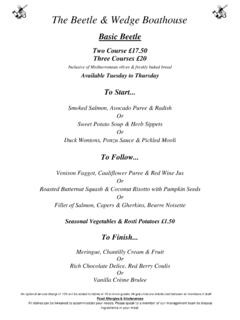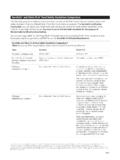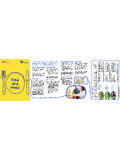Transcription of RPAH Elimination Diet Handbook - Emerge Australia
1 RPAHE limination DietHandbookwith food & shopping guide food &Shopping-p1-33_240x160_Feb2 17/3/09 6:45 PM Page 1bPublished in 2009 Text copyright Anne Swain, Velencia Soutter, Robert LoblayAllergy Unit, Royal Prince Alfred and selected photographs Anne Swain, Velencia Soutter, Robert images supplied by Suzy King Design Pty effort has been made to trace the ownership of copyright in other images included in this omission is entirely inadvertent and will be corrected in subsequent editions provided written notification is given to the rights reserved. With the exception of page 31, no part of this publication may be reproduced,stored or introduced into a retrieval system, or transmitted in any form or by any meanswithout prior written permission of the copyright owners and publishers of this Library of Australia Cataloguing-in-Publication entrySwain, A. R. (Anne Ruth)RPAH Elimination diet Handbook : with food & shopping guideAnne Swain, Velencia Soutter and Robert LoblayISBN: 9780980616408 (pbk)Includes index.
2 Cookery (Natural foods). food allergy diet allergy diet therapy Authors/Contributors: Soutter, V. L. (Velencia Lee), Loblay, R. H. (Robert Henry) by Suzy KingPrinted in Australia using soy based inks and green methods food &Shopping-p1-33_240x160_Feb2 17/3/09 6:45 PM Page 2 RPAHE limination DietHandbookwith food & shopping Anne Swain, Velencia Soutter, Robert LoblayAllergy Unit, Royal Prince Alfred Hospital food &Shopping-p1-33_240x160_Feb2 17/3/09 6:45 PM Page 3b7 Introduction8 food intolerance10 Natural food chemicals12 food additives12 Organic foods13 Infants13 Lactose14 Fructose15 food allergy16 Coeliac disease17 Adverse food reactions18 food reaction diagnosis19 Why do an Elimination diet ?21 Elimination dietA step-by step guide22 Getting started: Choosing the approach that suits you best23 The charts & shopping guide25 Additives to be avoided26 Reading food labels27 Elimination diet instructions29 Dietitian recommendations30 food and symptom diary33 food charts & shopping guide34 Fruits36 Vegetables38 Meat40 Seafood42 Eggs44 Legumes46 Nuts & seeds48 Baking aids, herbs, spices & condiments50 Fats & oils52 Jams, sugars, syrups & sweets54 Drinks & milk alternatives55 Calcium requirements56 Tea, coffee & alcohol58 Gluten content of foodscontents food &Shopping-p1-33_240x160_Feb2 17/3/09 6.
3 45 PM Page 4b59 Gluten-free foods60 Grains & flours62 Cereals64 Breads66 Pasta, noodles & wraps 68 Crackers, biscuits, cakes & snacks70 Gluten content of foods71 Gluten-containing foods72 Cereals, grains & flours74 Breads & pasta76 Crackers & biscuits78 Cakes, pastries, pancakes & desserts80 Lactose content of some common foods81 Dairy foods82 Milk, custard & ice cream84 Yoghurt, cheese & confectionery87 Soy88 Soy products91 Good nutrition92 Healthy eating guide93 Low chemical sources of major nutrients94 Calcium & vitamin D96 Recommendations for infants & children98 Recommendations for adults100 Using & adapting basic recipes101 Menu planning102 Free of egg, dairy, soy, gluten & nut104 Contains egg free of dairy, soy, gluten & nut105 Contains egg, dairy, soy, gluten free of nut107 Nutritional supplements109 Vitamin C recommended daily intake111 Toiletries & personal care products115 Medications121 Personal & home environment126 Index133 Acknowledgmentsyou best food &Shopping-p1-33_240x160_Feb2 17/3/09 6:45 PM Page 5 Allergy Unit, Royal Prince Alfred Hospital6notesHEALTH PROFESSIONAL CONTACT DETAILSDIETITIAN NAME:Phone.
4 Fax:..Mobile:..Email:..Address:..DOCTOR NAME:Phone:..Fax:..Mobile:..Email:..Addr ess:.. food &Shopping-p1-33_240x160_Feb2 17/3/09 6:45 PM Page 6 Allergy Unit, Royal Prince Alfred Hospital7bIntroductionBefore making any major changes to your diet , go and see your doctor. food chemical intolerances can be very unpleasant, but they don t generally cause permanent damage to the body. If you have persistent symptoms it s wise to first make sure some serious disease hasn t been picas discussed food &Shopping-p1-33_240x160_Feb2 17/3/09 6:45 PM Page 7 food intolerance Before investigating diet as a possible cause of your symptoms, it s importantto understand the difference between food intoleranceand food allergies. Allergies are immune reactions to unique protein components of a specific contrast, intolerances don t involve the immune system at all. They are triggered by various natural food chemicals and/or additives which cause reactions by irritating nerve endings in different parts of the body, rather like the way certain drugs cause with drugs, people with a sensitive constitution react more readily than others to food chemicals.
5 If you re susceptible to food intolerances, your reactions will depend on a number of FACTORS:What symptoms you re prone toSymptoms vary from person to person. The commonest ones are recurrent hives and swellings, stomach & bowel irritation, and headaches. Some people can feelvaguely unwell with flu-like aches & pains, or get unusually tired, run-down or moody. Children can be irritable and restless, with aggravation of behaviour problems such as ADHD. Babies can develop colicky irritable behaviour, reflux,loose stools, eczema and/or nappy rashes. Allergy Unit, Royal Prince Alfred Hospital 8 GASTROINTESTINALAIRWAYSNERVOUSSYSTEMFOOD intolerance SKIN tummyacheSYMPTOMS:Vary from person to person and can affect one or more system. food intolerance runs in families and usually affects the same system across generations. food &Shopping-p1-33_240x160_Feb2 17/3/09 6:45 PM Page 8 Allergy Unit, Royal Prince Alfred Hospital 9 What chemicals you re sensitive toThis is very individual.
6 Most people with food intolerance are sensitive to more than one substance. This can includenatural food chemicals (eg. salicylates, amines, glutamate) as well as one or more of the common food additives (page 25).How sensitive you areThe more sensitive you are, the less you will be able to tolerate of the chemical-rich foods. Speed of onset and severity of reactions can vary too. Symptoms can begin within an hour or two, but more often take several hours to develop. Typicalreactions last a few hours, but moresevere ones can sometimes go on forseveral much you eatDepending on your threshold for reacting, large doses may upset youwhereas smaller amounts may have no immediate effect. However, small amounts of salicylates and/or amines from many different foods eaten regularly can build up in your system or recurrent symptoms can then develop without the cause being DEPENDENCE: food intolerance reactions are dose dependent.
7 A small amount of a chemical rich food (eg. one or two strawberries; a slice of fresh tomato) may cause no symptoms, whereas a larger amount that exceeds your dose threshold (eg. a whole punnet of strawberries; tomato concentrated as sauce or paste) can provoke a reaction. Eating small amounts regularly can cause a gradual build-up with symptoms developing after a few days. THRESHOLD symptomssymptomsBUILD-UPTIMEDOSEno symptoms food &Shopping-p1-33_240x160_Feb2 17/3/09 6:45 PM Page 9 NATURAL food CHEMICALSN atural chemicals present in many healthy foods can be just as much of a problem for sensitive people as the artificial ones used as food additives. Foods vary greatly in natural chemical composition. The substances most likely toupset sensitive individuals salicylates, amines and glutamate are the ones common to many different foods and are therefore consumed in greatest quantity in the daily are a family of plant chemicals (2-hydroxybenzoates) found naturally in manyfruits, vegetables, nuts, herbs and spices, jams, honey, yeast extracts, tea, coffee, juices,beer and wine.
8 They are present in natural flavourings (eg. mint, fruit flavours) used infoods, drinks and liquid medications, and also as scents in perfumes, toiletries, cleaningproducts, washing powders, and botanical oils (eg. lavender, eucalyptus, tea-tree).ASPIRIN(acetyl salicylic acid) is a member of this chemical family. Natural salicylatesare active ingredients of many herbal medications because of their pain-killing andanti-inflammatory amines come from protein breakdown. Levels increase in protein foods (meats,fish, cheese) as they age or mature , and in fruits as they ripen (eg. bananas, tomato,avocado, pawpaw, olives). High levels are present in sauces, fruit juices, chocolate,flavoured spreads, nut and seed pastes & jams, and in fermented products (eg. beer,wines, yeast extracts).Allergy Unit, Royal Prince Alfred Hospital 10 CHEMICAL THRESHOLD: The small amounts of natural chemicals present in aparticular food may not be enough to cause a reaction straightaway.
9 However, becauseone substance may be common to many different foods it can accumulate in the body,causing a reaction when your dose threshold is finally exceeded. On this graph, all thefoods shown contain natural amines. Although the last food eaten (chocolate) is oftenblamed for a reaction, all the others have contributed as food &Shopping-p1-33_240x160_Feb2 17/3/09 6:45 PM Page 10 GlutamateGlutamate is an amino acid building block of all proteins and is found naturally in most foods. In its free form (not linked to protein) it enhances the flavour of is why foods rich in natural glutamate (eg. cheese, tomato, mushrooms, stockcubes, soy sauce, meat extracts, yeast extracts) are used to add flavour to the same reason, MSG (pure monosodium glutamate) is used as an additive in savoury snack foods, soups, sauces and Asian , chemical concentration and flavourAllergy Unit, Royal Prince Alfred Hospital 11 RIPENING, CHEMICAL CONCENTRATION AND FLAVOUR Amines and glutamateare formed in some fruits and vegetables as proteins break down.
10 Levels increase with ripening and softening (eg. banana, avocado, tomato).Salicylateshave natural anti-bacterial and preservative actions which protect plants from attack bymicrobes, insects and pests before they are ripe. For this reason, the highest concentrations are foundnear the surface of fruits and vegetables. Levels decrease with ripening (eg. apple, stone fruit). The concentration of salicylates and amines can also vary according to fruit variety and FLAVOURSALICYLATESGLUTAMATE & AMINESAs a general rule, the stronger the flavour of a food , the higher its natural chemical content is likely to fresh tomatoes are made into juice, soup, sauce or paste, the concentration of salicylates, amines and glutamate increases in parallel with the and/or cooking of meat and fish(especially browning, grilling or charring) enhances their flavour due to increased amine formation. food &Shopping-p1-33_240x160_Feb2 17/3/09 6:45 PM Page 11In the early 20th century, not long after ASPIRIN(acetyl salicylic acid) was first synthesized, it was widely used as a food preservative.






